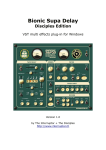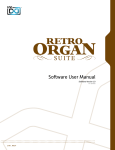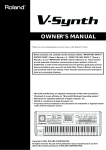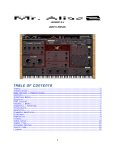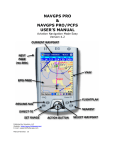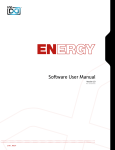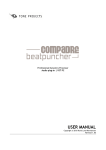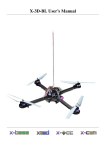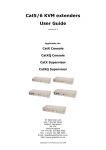Download User Manual - The Interruptor
Transcript
NIGHT FLIGHT analogue string ensemble VSTi for Windows Version 1.0 © by The Interruptor http://www.interruptor.ch all rights reserved Dedicated to my daughter Table of Contents 1 Introduction.......................................................................4 1.1 What is an analogue string ensemble?............................................4 1.2 Features.....................................................................................5 2 3 4 5 6 System Requirements.........................................................6 License............................................................................. 6 Demo Version....................................................................6 Installation........................................................................6 General Operation..............................................................7 6.1 6.2 6.3 6.4 6.5 Control Back-lighting....................................................................7 Manual Entry of Values.................................................................7 Fine Adjustment of a Control.........................................................7 Midi Learn...................................................................................7 Signal Flow Diagram.....................................................................8 7 Control Reference...............................................................9 7.1 Main Panel..................................................................................9 7.2 Sub Control Panels.....................................................................10 7.2.1 OSC+SYSTEM Panel..............................................................10 7.2.2 VCA Panel...........................................................................12 7.2.3 ENSEMBLE Panel..................................................................13 7.2.4 LFO+FILTER Panel................................................................15 7.2.5 EQUALIZER Panel.................................................................17 7.2.6 PHASER+DELAY Panel...........................................................18 8 Program History...............................................................19 9 Credits............................................................................ 19 NIGHT FLIGHT VSTi - User Manual 3 1 Introduction “Night Flight” is a VSTi plug-in for the Windows platform emulating a class of keyboards popular in the mid-seventies to early eighties which were known as string machines or string ensembles. 1.1 What is an analogue string ensemble? Many moons before the widespread arrival of polyphonic synthesizers in 1981 nifty engineers at Eminent Orgelbouw B.V. in the Netherlands discovered that their Orbitone system, an electronic circuitry built to affordably mimic the sound of a Leslie cabinet for home organists, could be easily modified to create a stunning new sound yet unheard from an organ. They introduced it as a feature to their 1972 model “Eminent 310 unique” under the name “string ensemble”. Honestly speaking it's sound hardly resembles anything like a real string ensemble, Image 1: Eminent 310 unique which however does not take away anything from the qualities these unique synthetic timbres have in their own right. The sound had great appeal with musicians, particularly after Eminent included a modification of the concept into a portable keyboard named the Solina string ensemble which was later re-branded as Arp String Ensemble for the US market. At the same time other companies like Crumar, Logan, Roland, Oberheim and Korg also released string machines following the same architecture combining organ-style divide-down oscillators with an ensemImage 2: Arp/Solina String Ensemble ble effect. String machines have been widely used in Pop, Rock, Funk, Reggae, Soul, and Disco music throughout the seventies and up to the early eighties when they were popular with New Wave acts. 4 NIGHT FLIGHT VSTi - User Manual 1.2 Features “Night Flight” does not use any samples. It is based on an emulation of the ensemble effect first used by Eminent / Solina back in 1972 and an organ-like sound generation (octave divider). You will also find a number of features inspired by other string machines like the 3 band equalizer from the Crumar Performer or the Envelope Filter on the very rare ARP String Synthesizer. Besides the clearly laid out main panel there are 6 sub panels giving access to a large number of under-the-hood parameters like filter and amplifier modulations, ADSR, LFO, keyboard split points, equalizer automation and two additional simultaneous ensemble effects for even thicker pad sounds. Finally there is an onboard effect section providing the typical phasing and delay effects which are essential for some of the best known string machine timbres. • 3 Oscillators (8 waveforms, pulse width control) • Up to three simultaneous ensemble effects modelled on the eminent/solina architecture. Full access to the internal parameters of the ensemble effects. • Optional divide-down mode featuring organ style phase-locked octaves • 3-Band Equalizer: Each band can be configured and automated via the LFO • Filter: 5 modes (LP2, LP4, BP, HP2, HP4), resonance, cutoff modulation via ADSR envelope, LFO, velocity or keyfollow • Amplifier section: - Attack and Release. Decay and Sustain are available as under-the-hood parameters. - For each oscillator a simple organ envelope can be selected as an alternative to the ADSR envelope. • 1 LFO routable to pitch (vibrato), Filter cutoff or equalizer automation. Optional note sync. • Selectable keyboard split points for bass and string footages • Effects section: - phaser (two models) + delay/echo - configurable effect routing NIGHT FLIGHT VSTi - User Manual 5 2 System Requirements • WINXP, VISTA, WIN7, WIN8 • A host software (DAW) capable of running VST plug-ins • This plug-in runs natively on 32bit systems. If you have a 64bit system, it is likely that your DAW provides support for 32 bit plug-ins via a so called “bridge”. If this is not the case you might consider acquiring a third party bridge instead. 3 License • By acquiring the full version you are granted the right to use this software on all of your computers for as long as you want. • You are not allowed to sell the software to someone else neither on it's own nor as part of a package with other goods or services. 4 Demo Version • Please install and test the demo version on your system before buying the full version. • Demo limitation: A short moment of silence is inserted once every 30 seconds. Otherwise the demo version has the complete functionality of the full version. 5 Installation • Copy the dll file from the download archive to your VST folder • Restart your host software (DAW) • Load the plug-in Note: In case of problems please read the following. Upon starting the plug-in for the first time a number of files are automatically extracted to your VST folder. On Windows versions from VISTA onwards by default plug-ins are not allowed to write files to your hard drive. This will typically cause an error message from your DAW reporting missing files. You can fix this issue by changing the write permissions for your VST folder as follows: • Use Windows Explorer to browse to your VST Plugins folder. 6 NIGHT FLIGHT VSTi - User Manual • • • • • • Right-click the folder – 'Properties' Choose 'Security' tab. Click 'Edit' button (You may need to click a UAC prompt). Select user name "Users". Tick options Allow 'Write' and 'Modify'. To finish Select 'OK' to close the two dialog boxes. 6 General Operation 6.1 Control Back-lighting • You can easily see if a control currently has an influence on the sound. Back-lighting is switched on only if this is the case. 6.2 Manual Entry of Values • Below each knob/slider the parameter value is displayed as a number. Instead of moving the control with the mouse you can manually enter the value via your PC keyboard by clicking on the number, writing the value and then pressing the ENTER key. 6.3 Fine Adjustment of a Control • Press the CTRL key while moving any control with the mouse if you need to make fine adjustments 6.4 Midi Learn • Each control can be automated via MIDI controllers. • To assign a new/different MIDI controller right-click on a control then choose "Learn" from the pop-up menu and tweak the hardware controller you want to assign. Alternatively choose "Unlearn" or "Edit.." to assign a controller from a list. 6.5 Signal Flow Diagram NIGHT FLIGHT VSTi - User Manual 7 8 NIGHT FLIGHT VSTi - User Manual 7 Control Reference 7.1 Main Panel OSCILLATORS • enable/disable each oscillator • set the volume of each oscillator VCA • set the main volume • adjust the attack and release phase of the volume envelope ENSEMBLE • enable/disable the ensemble effect • set stereo width of the ensemble effect LFO • RATE: speed of the Low Frequency • • EQUALIZER Oscillator VIBRATO: sets the amount of pitch modulation DELAY: provides a slow build-up of the vibrato effect after a note is pressed • Allows to quickly adjust the low, mid and high frequencies. See the equalizer panel if you want to automate the equalizer via the LFO or adjust the center frequencies and bandwidths. PHASER • enable/disable the phaser effect DELAY • enable/disable the delay/echo effect NIGHT FLIGHT VSTi - User Manual 9 7.2 Sub Control Panels • Press any of the sub control panel buttons to access a sub control panel • Press the KEYBOARD button to return to the on-screen keyboard 7.2.1 OSC+SYSTEM Panel 10 OCT Click the OCT button to transpose the pitch of an oscillator by one octave. Click the button repeatedly to reach a number of different octaves. “OCT+0” is the default setting where the three oscillators are spaced by one octave from each other. ADSR / ORGN You can select the loudness envelope shape for each Oscillator: • ADSR: The oscillator loudness is following an ADSR envelope defined by the Attack and Release parameters on the main panel and the Decay and Sustain parameters on the VCA sub panel. • ORGN: The oscillator is switched on and off immediately when pressing and releasing a key like on an organ. NIGHT FLIGHT VSTi - User Manual ADSR ORGN WAVE Select one out of 8 wave shapes for each oscillator (Sine, Sine2, Saw, Saw2, Tri, Tri2, Pulse, Noise). Saw2 is modeled after the string ensemble waveform of the Eminent 310. PW Sets the pulse width for the pulse wave shape DIVIDE-DOWN MODE By clicking repeatedly you can toggle through the options OFF, 8'+4' ONLY and FULL. • Enable the option FULL to phase-lock all • octaves played on the keyboard. This corresponds to the classic divide-down organ-style sound generation used on string machines. By selecting the option 8'+4' ONLY you can exclude the bass oscillator from the phase-locking Background: This plug-in emulates the classic organ sound generation by synchronizing the three oscillators to a master oscillator. In some situations this method might cause undesired clicks at the note start. You are more likely to observe this if your sound has several of the following characteristics: - very low frequencies - short attack phase - no low pass filtering enabled Generally speaking the option FULL should be chosen for string / pad type sounds, particularly if you want to play full chords including octaves. For bass lines or lead / melody playing the option OFF is suitable. KEYBOARD ZONES Night Flight provides two keyboard zones: • BASS: By moving the inner knob of the NIGHT FLIGHT VSTi - User Manual 11 • EFFECT STRUCTURE dual concentric pot you can define the highest key to which the bass oscillator will respond. 8' + 4': Use the outer ring of the dual concentric pot to define the lowest key to which the 8' and the 4' will respond. • Enable this button to let the bass oscillator bypass the ensemble effect and route it through the filter. This way you get a clear and punchy bass to complement your string section. 7.2.2 VCA Panel 12 DECAY + SUSTAIN These two controls complement the ATACK and RELEASE controls on the main panel to give you a full ADSR envelope. VELOCITY Controls the impact of key velocity on the loudness of all oscillators. NIGHT FLIGHT VSTi - User Manual 7.2.3 ENSEMBLE Panel In order to make full use of the parameters on this panel you need to understand how a string ensemble effect works. The following paragraph aims to provide you with the necessary know-how to successfully tweak your own string timbre. Be careful with these settings since there tends to be a thin line between a rich ensemble and something completely unimpressive. • The Eminent/Solina type string ensemble effect is a variation of the classic chorus effect. • A typical characteristic of a real string ensemble is that the individual musicians are never completely in tune even when playing the same note. This can be simulated by means of modulated delay lines. By varying the delay time of a delay line the pitch of the notes played is also affected. You might know this phenomenon if you ever owned an old tape deck or record player with an unstable playback speed. • There are three delay lines. The delay time of each is modulated at the same time by two sine-shaped low frequency oscillators. • The trick is that there are actually only two of these sine oscillators for all three delay lines. In order to create a different modulation signal for each delay line two Image 3: Eminent 310 ensemble effect phase shifted sine waves are deducted from each oscillator with an offset of 120 respectively 240 degrees from the original signal. The three modulation signals from each oscillator are thus equal in shape but their phasings are evenly distributed around the 360 degrees of the full circle. This results in a very NIGHT FLIGHT VSTi - User Manual 13 harmonious chorus effect without the dreaded beating that can be heard on simple chorus units. • Nightflight contains three of the ensemble effects described above. This allows to create wide stereo pads that are still very dense. Also you can create extra rich ensemble timbres by connecting two ensemble effects in series. As an alternative the exact stereo output configuration of the Eminent 310 (see Image 3) can also be selected. Image 4: Nightflight Ensemble Architecture 14 DRY/WET Sets the mix of the ensemble sound vs. the original signal. DEPTH Overall modulation amount. Set this to zero and the delay lines will not be modulated at all RATE 1 Rate of sine oscillator 1 DEPTH 2 Modulation amount of sine oscillator 2. This will only have an effect if the overall modulation amount “DEPTH” is higher than zero RATE 2 Rate of sine oscillator 2 NIGHT FLIGHT VSTi - User Manual SYMMETRY This will skew the phase angles of the modulation signals resulting in an irregularly moving chorus effect. Set the control to zero to get the original angles of 0, 120, 240 degrees. This control will affect ensembles A, A' and B at the same time. CLIP Use this control to clip the sine waves generated by the two modulation oscillators. The more you clip the more the signals will resemble a rectangle. A value of zero creates no clipping. This control will affect ensembles A, A' and B at the same time. DUAL Enables / Disables ensemble B TWIN STEREO ON: Ensembles A and A' are both enabled and panned to the left and to the right. Ensemble A' receives the same three modulation signals as ensemble A but they are inverted. This results in a wide and dense stereo effect. OFF: This corresponds to the stereo configuration of the Eminent 310: Ensemble A' is disabled. The outputs of the three delay lines of ensemble A are used to create a stereo effect as displayed in image 3. 7.2.4 LFO+FILTER Panel LFO NOTE SYNC Enable this function to reset the main LFO and the phaser LFO each time a note is played. PHASE Sets the start phase to which the LFOs are reset. NIGHT FLIGHT VSTi - User Manual 15 SMART If you enable this function the LFOs are only reset if a short time has passed since the last note was released. This way you can play a melody line or a chords progression while the LFOs keep on running. The LFOs will be reset again as soon as you start playing the next melody line / chord progression. FILTER 16 TYPE Selects the filter type or disables the Filter: Lowpass 2, Lowpass 4, Bandpass, Highpass 2, Highpass 4, OFF SETUP Use this control to define the filter characteristics: • FRQ: By moving the inner knob of the dual concentric pot you can set the filter cutoff frequency. • RES: Use the outer ring of the dual concentric pot to set the filter resonance. KEY FOLLOW If set to a value higher than zero the filter cutoff frequency will follow the notes played: High notes will be played with the filter set to a higher cutoff frequency than low notes MODULATION The filter cutoff frequency can be either modulated by the LFO or by the ADSR envelope • LFO: By moving the inner knob of the dual concentric pot you can set the amount of LFO modulation • ADSR: Use the outer ring of the dual concentric pot to set the amount of modulation by the Filter envelope. ATTACK DECAY SUSTAIN RELEASE Use these parameters to define the filter envelope. VELOCITY Controls the impact of key velocity on the filter cutoff frequency. NIGHT FLIGHT VSTi - User Manual 7.2.5 EQUALIZER Panel The controls on this panel complement the Equalizer on the main panel. You can set the center frequency and bandwidth of each band. Additionally each band can be modulated by the LFO in two different ways. FILTER • FRQ: By moving the inner knob of the • MODULATION dual concentric pot you can set the center frequency Q: Use the outer ring of the dual concentric pot to set the bandwidth. • FRQ: By moving the inner knob of the • dual concentric pot you can define the amount of LFO modulation applied to the center frequency GAIN: Use the outer ring of the dual concentric pot to set the amount of LFO modulation applied to the filter gain. NIGHT FLIGHT VSTi - User Manual 17 7.2.6 PHASER+DELAY Panel PHASER RATE Sets the modulation rate of the phaser's sweeping LFO. Note: The phaser has it's own LFO with it's own rate. But the LFO synchronizing options found on the “LFO+FILTER Panel” do also work for the phaser LFO (Note Sync, Phase, Smart Mode) LO FRQ Lowest Frequency reached while sweeping HI FRQ Highest Frequency reached while sweeping FEEDB Phaser feedback VINTAGE Enable this button to get a phaser sound which is close to a small stone phaser pedal STEREO A stereo phasing effect is generated by delaying the sweeping oscillator of one channel DELAY 18 DRY/WET Sets the amount of delay effect added to the dry signal PAN Allows to pan the dry signal to one side and the delay effect to the other. TIME Defines the delay time FEEDBACK Higher values at this control will create more repetitions HP High pass filter in the delay feedback loop LP Low pass filter in the delay feedback loop NIGHT FLIGHT VSTi - User Manual 8 Program History • v.1.0 - March 2013 initial release 9 Credits • Built with Synthedit by Jeff Mc Clintock http://www.synthedit.com • Third Party modules were used by David Haupt, Dan Worrall, Attilla Füstös • GUI controls were created using Knobman http://www.g200kg.com/en/software/knobman.html • The executable was packed using UPX http://upx.sourceforge.net NIGHT FLIGHT VSTi - User Manual 19



















